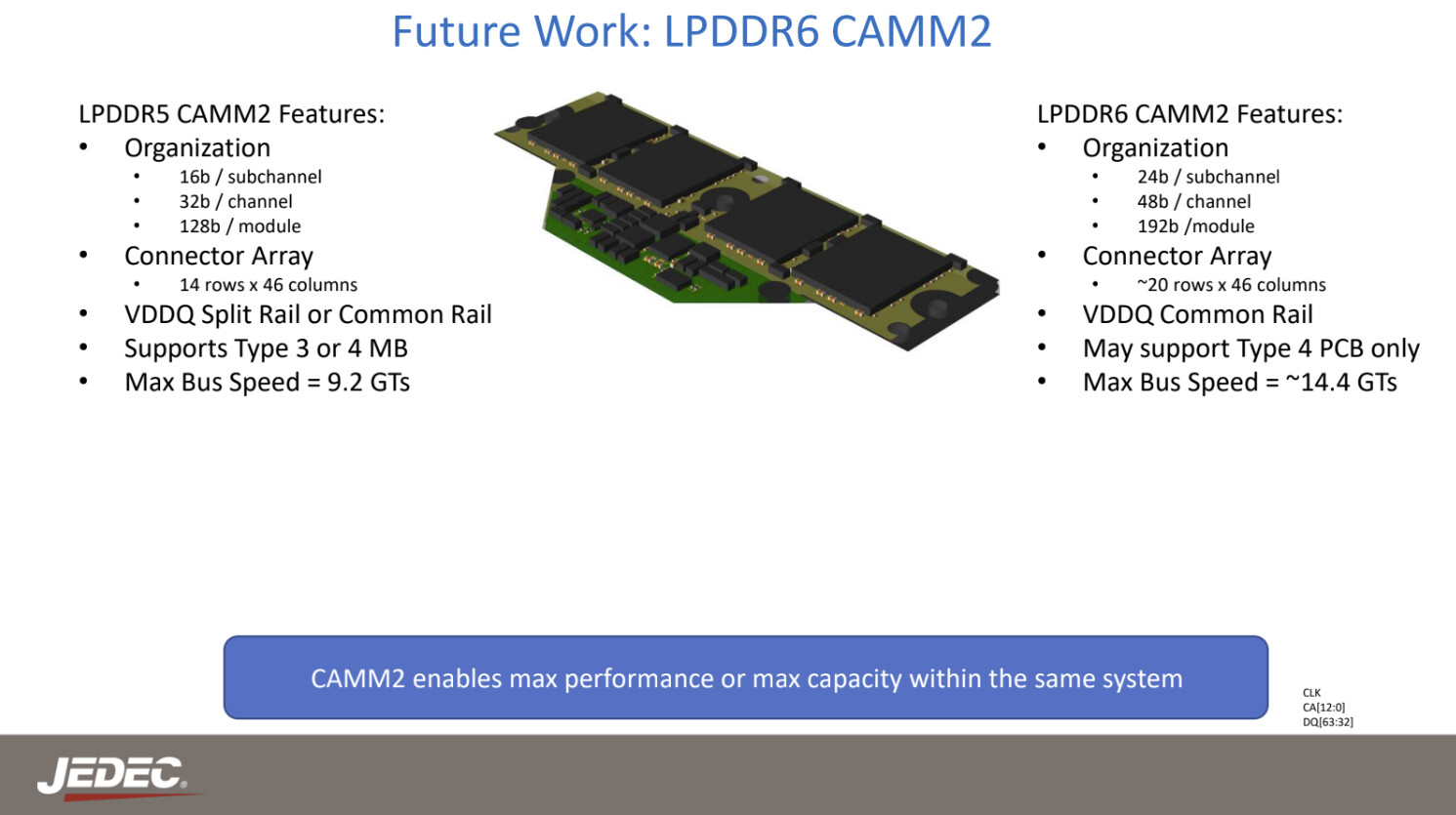- Joined
- May 21, 2024
- Messages
- 718 (3.40/day)
In actively verifying its next-generation CAMM2 (Compression Attached Memory Module 2) memory modules, global memory leader Team Group Inc. today announced two specifications: consumer-grade CAMM2 DDR5 7200 MHz and industrial-grade CAMM2 DDR5 6400 MHz. These new products provide expanded options for the memory market, delivering faster data transfer speeds, enhanced performance, and greater user flexibility.
The consumer-grade CAMM2 memory from Team Group operates at DDR5 7200 MHz CL34-42-42-84 under manual overclocking, delivering exceptional performance. Compared to the default JEDEC specification, the module offers write, copy, and read speeds of up to 108,000 MB/s, 106,000 MB/s, and 117,000 MB/s, respectively, while reducing overall latency to 55ns. The module delivers smoother performance when running large applications, gaming, or multitasking. The potential to achieve ultra-high frequencies of 8000-9000 MHz in the future further underscores its superior capabilities. In addition, Team Group Industrial is developing an industrial-grade CAMM2 memory, optimized for DDR5 6400 MHz, which is designed for industrial control, edge computing, and AI applications, providing robust support for high-performance computing and real-time data processing. The module will play a critical role in the development of technologies such as smart manufacturing, autonomous driving, and smart cities by improving both performance and reliability.



Compared to traditional SO-DIMM, U-DIMM, and R-DIMM memory, CAMM2 introduces a breakthrough design with several distinct advantages. It supports dual-channel mode with a single memory module, simplifying system architecture and significantly reducing power consumption. With an integrated CKD (Client Clock Driver) for improved signal integrity, CAMM2 memory is smaller and ideal for thin and light notebooks. Its improved thermal design allows for greater heat dissipation efficiency, unlocking more potential in a compact space. CAMM2 memory surpasses previous standards in overclocking, read speed, and latency, delivering an exceptionally smooth user experience. Through rigorous testing, Team Group has maximized the capabilities of CAMM2 to create endless possibilities for the memory market.
Team Group will continue to invest in CAMM2 technology, advancing both consumer and industrial specifications to deliver high-performance, reliable memory solutions. The Team Group CAMM2 memory series is expected to be released in Q1 2025, bringing a new experience to consumer PCs and industrial applications. Stay tuned to Team Group's official website and social media channels for the latest news.
The following screenshots are from a burn-in using the Intel i9-14900K processor with the Z790 PROJECT ZERO (CAMM2) motherboard. This test environment used an Intel i9-14900K processor paired with the Z790 PROJECT ZERO (CAMM2) motherboard.


View at TechPowerUp Main Site | Source
The consumer-grade CAMM2 memory from Team Group operates at DDR5 7200 MHz CL34-42-42-84 under manual overclocking, delivering exceptional performance. Compared to the default JEDEC specification, the module offers write, copy, and read speeds of up to 108,000 MB/s, 106,000 MB/s, and 117,000 MB/s, respectively, while reducing overall latency to 55ns. The module delivers smoother performance when running large applications, gaming, or multitasking. The potential to achieve ultra-high frequencies of 8000-9000 MHz in the future further underscores its superior capabilities. In addition, Team Group Industrial is developing an industrial-grade CAMM2 memory, optimized for DDR5 6400 MHz, which is designed for industrial control, edge computing, and AI applications, providing robust support for high-performance computing and real-time data processing. The module will play a critical role in the development of technologies such as smart manufacturing, autonomous driving, and smart cities by improving both performance and reliability.



Compared to traditional SO-DIMM, U-DIMM, and R-DIMM memory, CAMM2 introduces a breakthrough design with several distinct advantages. It supports dual-channel mode with a single memory module, simplifying system architecture and significantly reducing power consumption. With an integrated CKD (Client Clock Driver) for improved signal integrity, CAMM2 memory is smaller and ideal for thin and light notebooks. Its improved thermal design allows for greater heat dissipation efficiency, unlocking more potential in a compact space. CAMM2 memory surpasses previous standards in overclocking, read speed, and latency, delivering an exceptionally smooth user experience. Through rigorous testing, Team Group has maximized the capabilities of CAMM2 to create endless possibilities for the memory market.
Team Group will continue to invest in CAMM2 technology, advancing both consumer and industrial specifications to deliver high-performance, reliable memory solutions. The Team Group CAMM2 memory series is expected to be released in Q1 2025, bringing a new experience to consumer PCs and industrial applications. Stay tuned to Team Group's official website and social media channels for the latest news.
The following screenshots are from a burn-in using the Intel i9-14900K processor with the Z790 PROJECT ZERO (CAMM2) motherboard. This test environment used an Intel i9-14900K processor paired with the Z790 PROJECT ZERO (CAMM2) motherboard.


View at TechPowerUp Main Site | Source








